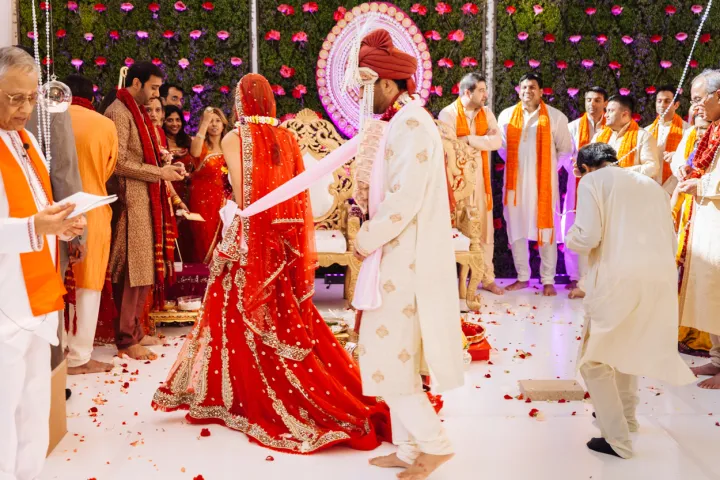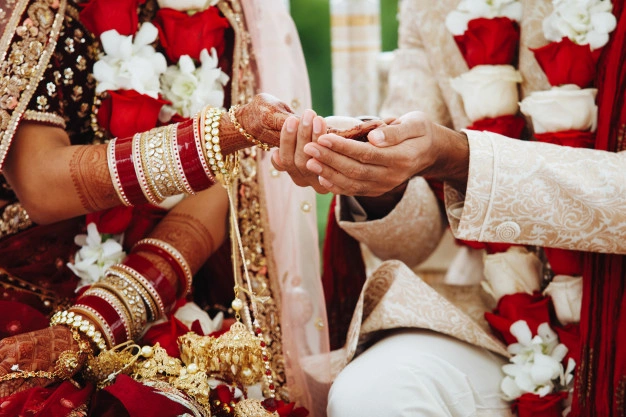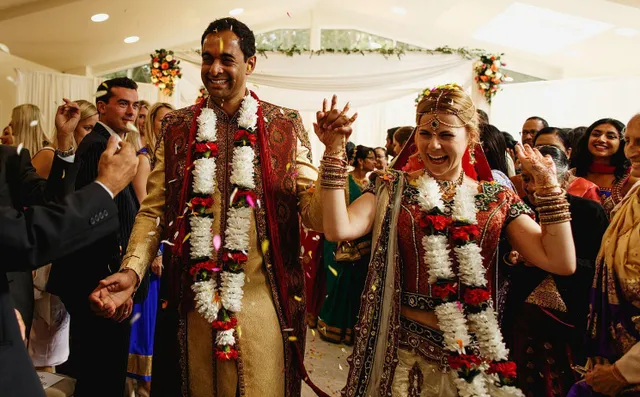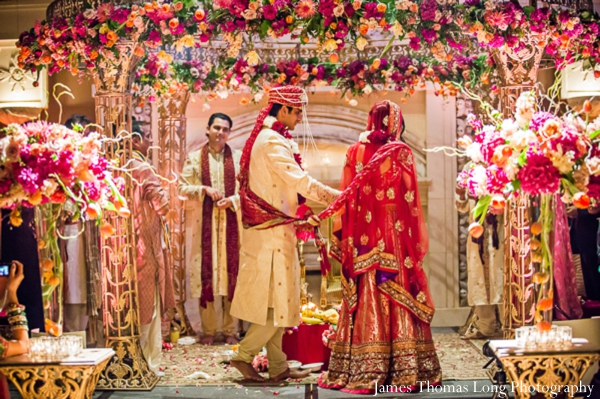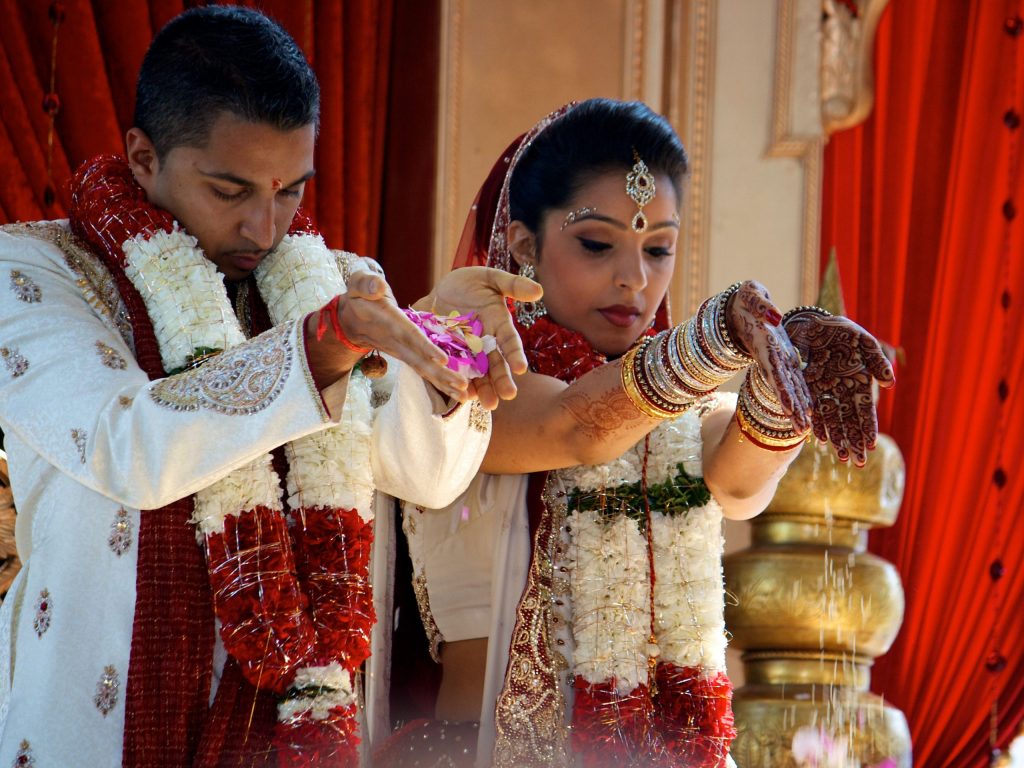Bhartiya Culture
Significance of Tilak or Bindi in Hinduism
Published
5 years agoon
By
Vedic Tribe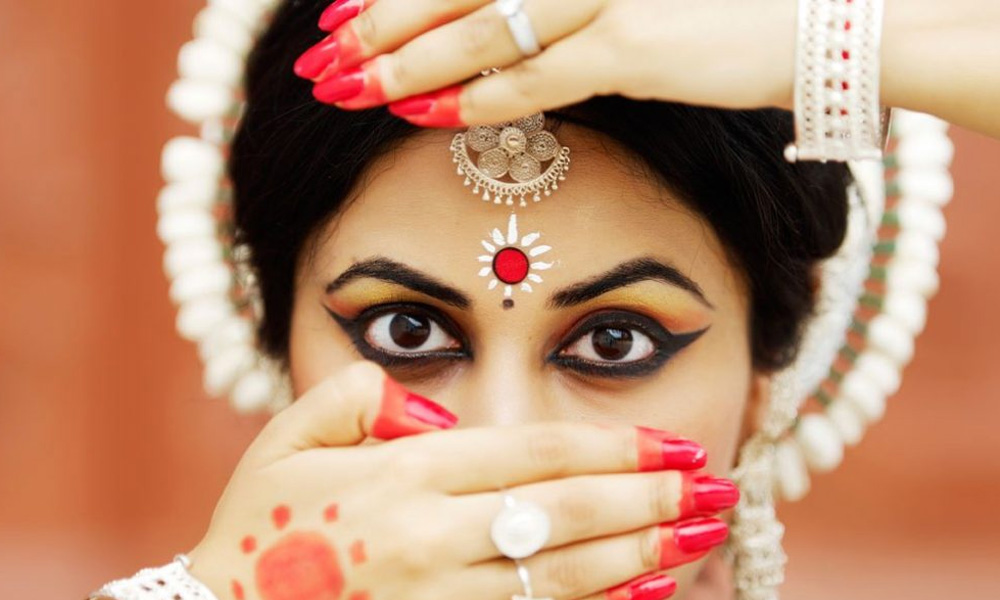
The term “bindi” stems from the Sanskrit word bindu, which means drop or particle. Because of the many languages and dialects spoken throughout India, it is important to note that bindis are otherwise known by many other names, including kumkum, sindoor, teep, tikli and bottu.
However, the meaning behind the ornament, regardless of region or language, remains the same.
Around 3000 BC, the rishi-muni (ancient seers of Hinduism) wrote the Vedas, in which they described the existence of areas of concentrated energy called the chakras. There are seven main chakras that run along the center of the body, and the sixth one (called the ajna chakra, the “brow chakra” or “third eye chakra”) occurs exactly where the bindi is placed.
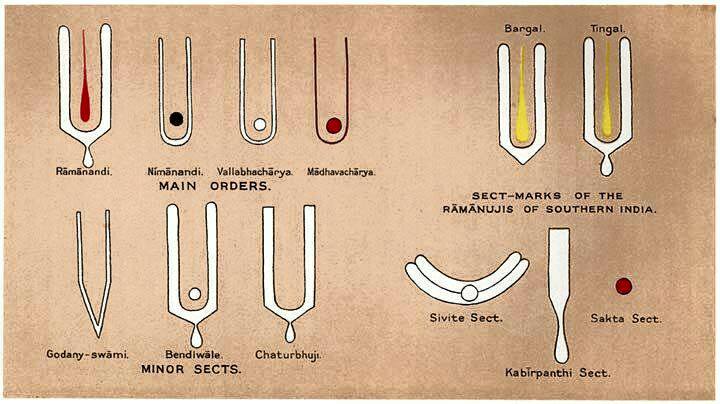
In Sanskrit, ajna translates as “command” or “perceive,” and is considered the eye of intuition and intellect. According to the Vedas, when something is seen in the mind’s eye or in a dream, it is also seen by ajna. Thus, the bindi’s purpose is to enhance the powers of this chakra, specifically by facilitating one’s ability to access their inner wisdom or guru, allowing them to see the world and interpret things in a truthful, unbiased manner as well as forsake their ego and rid their false labels.
Hindu tradition holds that all people have a third inner eye. The two physical eyes are used for seeing the external world, while the third focuses inward toward God. As such, the red dot signifies piety as well as serving as a constant reminder to keep God at the center of one’s thoughts.
SIGNIFICANCE OF A BINDI FOR A MARRIED WOMAN:
The bindi, especially a red-colored one, also serves as an auspicious sign of marriage. As the Hindu bride steps over the threshold of her husband’s home, her red bindi is believed to usher in prosperity and grant her a place as the family’s newest guardian. As such, when a woman is widowed, she no longer wears a red bindi due to its association with marriage. At most, she will wear a black dot on her forehead.
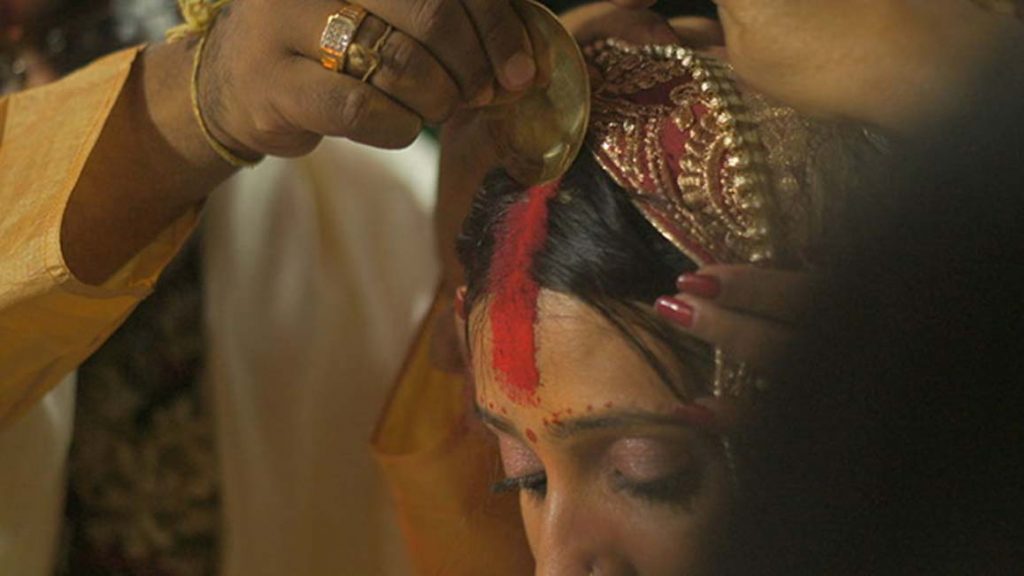
SIGNIFICANCE OF A BINDI FOR A MARRIED WOMAN:
USE OF THE BINDI IN A SPIRITUAL WAY:
In a spiritual view, bindi plays the most important role in Hindu culture. Every morning a Hindu takes a bath and sits in prayer just to seek the absolute truth through every prayer. However, it is true that one cannot sit in prayer the whole day. So when you leave the prayer room, you are expected to put some mark on your forehead, to remind you throughout the day about all the activities and the purpose of life. It is obvious you cannot see the mark on your own forehead every time so whenever you see it on another face, you will get a chance to recall the purpose of your life. The idea is to remember that all the things you are doing are dedicated towards the achievement of this supreme goal of self realization.
USE OF BINDI IN THE SOCIETY:
Society has always wanted to categorize or tag people in groups and the bindi performed a similar function in the ‘Social’ realm. The social purpose was to ward of the evil eye of the young unmarried girl by making her wear a ‘black’ Bindi. The married women wore a red Bindi. The 4 castes wore different coloured tilak though this is not followed except in very conservative families in the villages.
1. The Brahmins who were priests or academicians wore a tilak of white sandal wood signifying purity.
2. The Khatriyas (Kings, Warriors and Administrators) wore red tilak to signify valor.
3. The Vaishyas (Business men) wore a yellow tilak signifying prosperity.
4. The Sudra (service class) wore black tilak to signify service to the other classes.
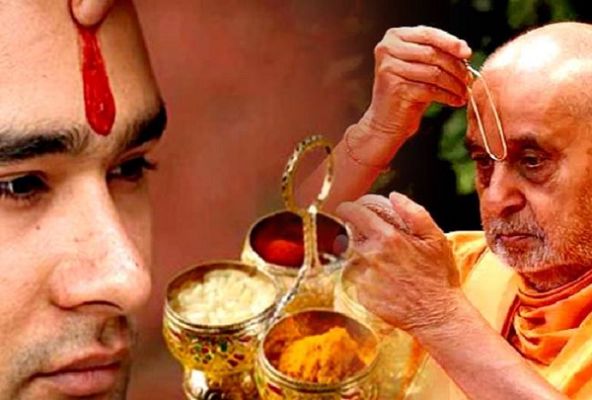
USE OF WEARING BINDI FROM A HEALTHY VIEWPOINT:
From a health point of view, the bindi is worn between the eyebrows where the pineal gland lies. This is an important nerve center and applying sandalwood or ash keeps the nerves cool and so keeps one cool and conserves energy. In the past the bindi was made from the yellow and red sandalwood, red and yellow turmeric, saffron, various flowers, ash, zinc oxide. All these had cooling properties in nature. Today people wear bindis made with glue or glass and doesn’t benefit in any way but is more of an accessory.
SPIRITUAL SIGNIFICANCE OF A BINDI:
The Ajna Chakra is considered to be the place of the “Third Eye” where one applies the Bindi. The Ajna Chakra is the site where one finally loses Ahamkara (ego or sense of individuality) when one achieves self-realization or reaches a higher level of spirituality. It is a way to remind one another in the society to see through the mind’s eye and see the bigger picture of the “Universe as One”.
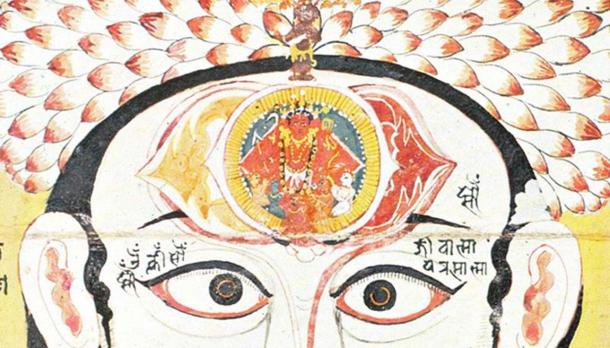
18th Century illustration from Rajasthan depicting the ajna chakra. ( Public Domain )
In modern times, however, the bindi’s symbolism is no longer strictly adhered to. Bindis now come in all shapes, sizes and colors, and are largely used as beauty accessories.
This evokes the question of cultural appropriation, as many Hollywood celebrities (Vanessa Hudgens, Gwen Stefani, Selena Gomez) have began wearing the bindi as a fashion statement. While some individuals with traditional bindi-wearing cultures criticize this act, there are others who view it simply as an attempt to embrace Indian culture.
You may like
-


Seven Vows and Steps (pheras) of Hindu Wedding explained
-


Sari or Saree is symbol of Indian feminism and culture
-


Atithi Devo Bhava meaning in Hinduism and India
-


Sanskrit Is More Than Just A Method To Communicate
-


Navaratri: The Nine Divine Nights of Maa Durga!
-


Significance of Bilva Leaf – Why is it dear to Lord shiva?
Bhartiya Culture
Seven Vows and Steps (pheras) of Hindu Wedding explained
Published
4 years agoon
November 11, 2021By
Vedic Tribe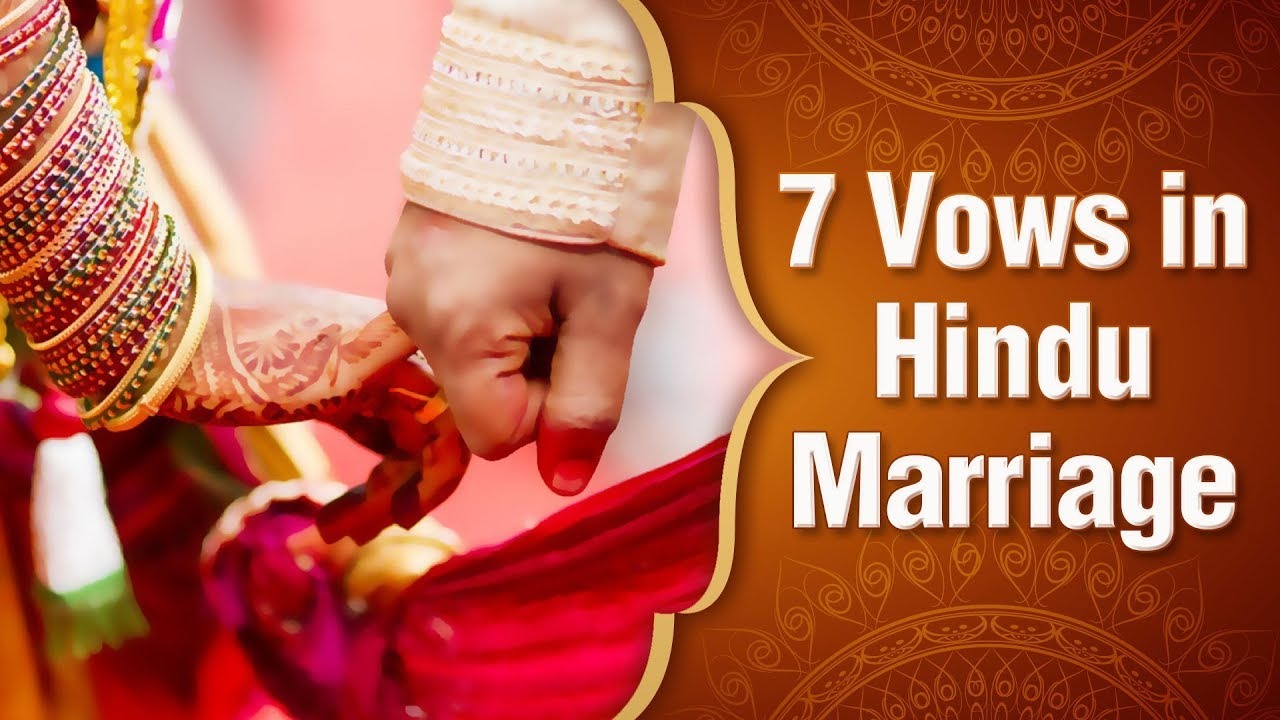
Indian marriages are well renowned around the world for all the rituals and events forming part of the marriage ceremony. Whether it is a week long celebrations before the actual wedding date or night long parties, the joy and exuberance evident in Indian weddings is simply unparalleled.
Among various ceremonies and sacred rites; there exists ritual of 7 pheras (encirclements or roundabouts) that is considered as one of the most sacred and significant ritual of them all. 7 pheras also called Saptapadi (in Sanskrit language) basically refer to the ceremony of walking around the sacred fire seven times at the time of wedding. As in Hindu religion, it is believed that the “fire or agni” is the maintainer of life and all the Gods and Goddesses are always present around this sacred fire, so the bride and bridegroom are required to take this ritual together around the holy fire that is believed to be representing Agni Devta or God of Fire. The first three pheras are completed with the bride leading and in the rest pheras groom leads the way. Before diving into the significance of each phera lets have a look at that how the pheras are actually performed?
How are 7 pheras performed?
The ritual of 7 pheras is performed under the guidance of a priest, also called pandit in Hindi language. The priest (pandit) utters aloud the religious sayings (mantras), while the Hindu bride and the Hindu groom sit around the holy fire. After specific instructions from the priest, the bride and the groom rise up and walk around the fire seven times & with the completion of the 7th phera the ritual of 7 pheras is said to be completed.
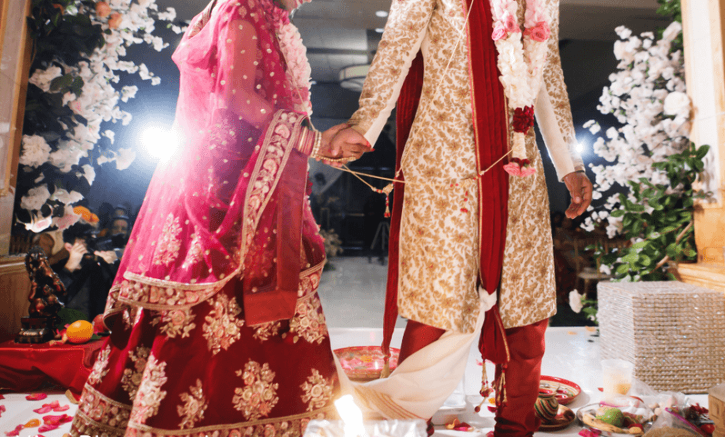
Significance of each pherab
As the name suggests, the ritual of pheras comprises of 7 pheras in all. Each phera has a distinct significance and meaning for the bride and the groom; a brief of which is mentioned below: –
1st Phera
In the first phera , the couple pray to God to extend his blessings on them in the form of healthy food and respectful life. First phera also indicates that God is the only ultimate deity, who can bless the couple with boon of honorable life and wholesome food
Bridegroom’s pledge/promise
As uttered in Sanskrit language “Om esha ekapadi bhava iti prathaman”
By performing the first phera lets promise to each other that our love shall become more intense with each passing day. We will help each other in every possible manner. You will cook food for me. I will bestow my love and affection upon you and shower my goodness during this journey of our married life. I will treat you kindly along with lots of love, so as to keep you happy and healthy.
Bride’s pledge/promise
As uttered in Sanskrit language “Dhanam dhanyam pade vadet”
I will wholeheartedly accept your judgment. I promise you that I will fulfill all the responsibilities of your family with utmost care and dedication. I will take care of your honor and remain abided by your love forever.
2nd Phera
In the second phera, the couple pleads to God for imparting them with mental stability, physical health and spiritual strength so that they can live there life smoothly after getting entangled in this pure relation of being husband-wife forever
Bridegroom’s pledge/promise
As uttered in Sanskrit language “Om oorje jara dastayaha”
By performing the ritual of second phera let us promise to each other that we will stand by each other forever. You will be initiating my strength and courage along with me. Together, we shall defend our home and family from all types of odd things and evil power.
Bride’s pledge/promise
As uttered in Sanskrit language “Kutumburn rakshayishyammi sa aravindharam”
I will always fill your heart with exuberant courage and strength. I pledge that I will utter only pleasant words. I shall be supporting you in protecting our family and children from evil powers. You shall love only me as your life partner.
3rd Phera
In the third phera, The couple invoke the God to provide them with uttermost wealth, wisdom and prosperity so that they can live contented and satisfied ever after. Third phera also signifies the importance of religious and sacred responsibility which shall be performed by the couple in there future life.
Bridegroom’s pledge/promise
As uttered in Sanskrit language “Om rayas Santu joradastayaha”
By performing the ritual of third phera, let us promise each other that we will remain spiritually abide by each other. I will look towards other woman only as my sisters. We shall grow and flourish together under the sacred and holy sanctity of God.
Bride’s pledge/promise
As uttered in Sanskrit language “Tava bhakti as vadedvachacha”
I will love you for whole of my life. I will consider all other men as my brothers. My love and respect for you will never fade. By virtue of my love and devotion I will remain as a chaste wife.
4th Phera
In the fourth phera, the couple prays to the god for bestowing happiness and rapport on them. Fourth phera also signifies the importance of family, parents and elders. Fourth phera bring out a commitment between the two souls that they will remain pledged to take care of there elders, family members and parents for rest of there life.
Bridegroom’s pledge/promise
As uttered in Sanskrit language “Om mayo bhavyas jaradastaya ha”
By performing the ritual of fourth phera, let us promise each other that we will provide utmost aid to our elders and parents. You will bring fortune and sanctity in my life. May god bless us with an ecstatic life and healthy children
Bride’s pledge/promise
As uttered in Sanskrit language “Lalayami cha pade vadet.”
I will decorate myself with jewelry, flowers and garlands just for you. Euphoria of my fragrance will be bestowed on only you. I will serve you and please you in every possible way.
5th Phera
In the Fifth Phera , the couple pray to almighty to bless his kindness for all the living things of this universe. They pray for the happiness and well being of each others relatives and friends. Fifth Phera denotes the bride’s and bridegroom’s concern with each other’s family members and relatives. It also signifies their moral responsibilities towards the charities and universe welfare. Another importance of fifth Phera is that they pray for a noble breed.
Bridegroom’s pledge/promise
As uttered in Sanskrit language “Om prajabhyaha Santu jaradastayaha”
Dear, we have walked four steps together. By taking this fifth steps with me, you have enriched my life. May you be blessed with every happiness. May our loved ones live long and happy life. Please come and share my duties for all charity acts. Come with me so we can enrich our family and get blessed with noble, righteous and brave children.
Bride’s pledge/promise
As uttered in Sanskrit language “Arte arba sapade vadet”
I will be with you in all the circumstances. I will share your happiness and joy and I will also share your grieves. Your love will give me strength to trust and respect you. My utmost concern would be your wish fulfillment. I pledge to do all possible tasks to carry out your wishes.
6th Phera
By performing Sixth phera couple implore for a long and happy life. They pray to almighty to extend his blessings for a long lived togetherness. They wish to enjoy endless plentiful seasons with each other. Sixth phera is completely related to the long, joyous life and togetherness.
Bridegroom’s pledge/promise
My Love, you have added immense happiness to my life, by taking six steps with me. My heart is filled with joy. I wish to have you always by my side. May you be with me forever and glut my life with pleasure and peace
Bride’s pledge/promise
As uttered in Sanskrit language “Yajne home shashthe vacho vadet”
I assure you that I will always walk beside you. I promise you that I will happily participate with you in all your noble acts. I will stand with you to perform the jobs to enrich our mercenary prosperity and enjoyment. I will also extend my efforts for all your devotional duties
7th Phera
Seventh Phera is the last phera which adds completion to the ritual of seven pheras. In seventh Phera , Bride & Bridegroom plead for a joy full life. The couple begs the god for a long lasting bond enriched with good understanding, loyalty and companionship. They pledge to bear the relationship with love and honesty. The couple invokes and also prays for universal peace as well as social welfare.
Bridegroom’s pledge/promise
As uttered in Sanskrit language “Om sakhi jaradastayahga.”
My beloved, we have performed seven pheras together and now we have a single identity. Henceforth we would be incomplete without each other. Our existence is entirely devoted to each other. I am completely yours and you are completely mine. Our bond has become perpetual. May we have an everlasting marriage.
Bride’s pledge/promise
As uttered in Sanskrit language “Attramshe sakshino vadet pade.”
With the pious of seven steps, I have been privileged to be your wife. I promise you to be always truthful. We will love each other forever. All the promises we have taken during this holy ritual, we will do all the possible to carry out the same with pure intentions. We pledge to be transparent with each other.
Bhartiya Culture
Sari or Saree is symbol of Indian feminism and culture
Published
4 years agoon
November 11, 2021By
Vedic Tribe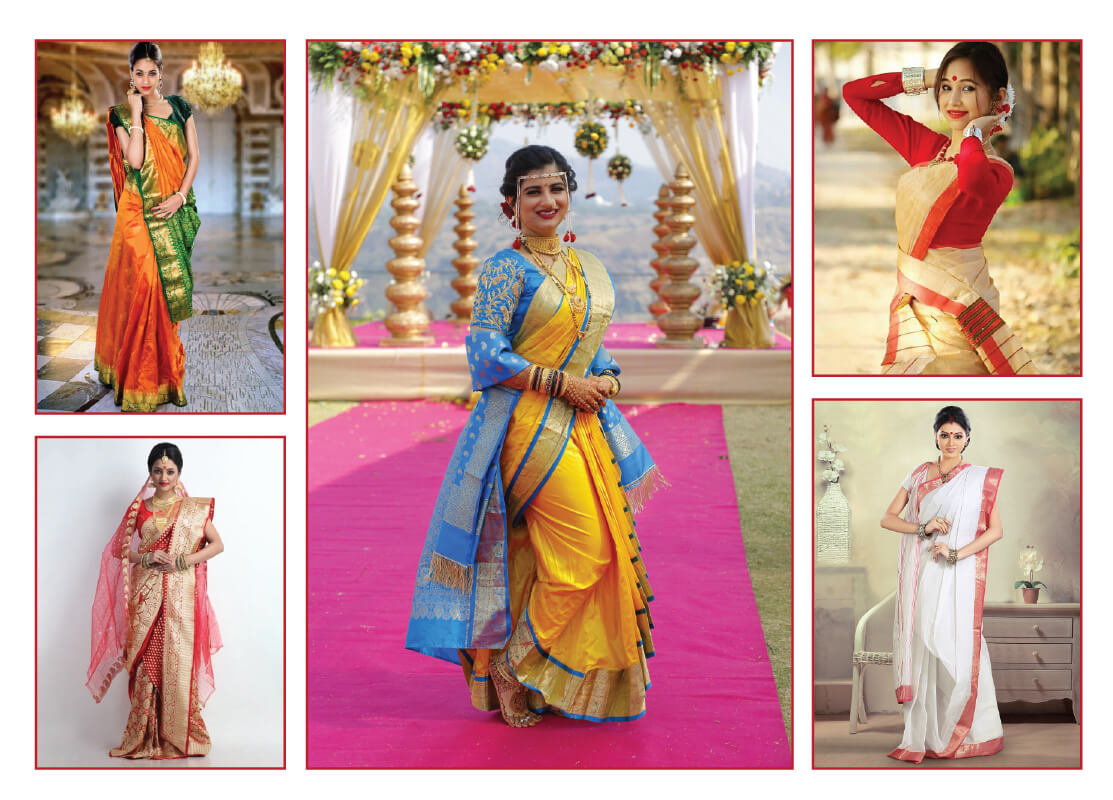
One of the most sensual attires of a woman in India is undoubtedly the sari. It is a long unstitched piece of cloth, usually 6 yards long that is draped in a set pattern. It accentuates the curves of a woman and the mid-riff is usually exposed. However, the way of draping a saree may differ from place to place. The way it is draped in the north may be slightly different from how it is draped in the south. It is available in a plethora of fibers, designs and colors. The sari is usually worn with a blouse that covers the upper part of the body and underneath it is the petticoat, which helps to tuck in the pleats of the saree to hold it in place.
History of Sari:
The history and origin of sari seems to date back to the period of the establishment of civilization. Evidence states that women in the Indus Valley civilization used to cover themselves with a long piece of cloth, draped like a trouser. However, the word ‘sari’ originated from the Prakrit word ‘sattika’, which is mentioned in the early Buddhist literature. The word got shortened and was called sati, which further evolved into sari.
A statue recovered from the Indus Valley Civilization depicts a female priest wearing a cloth draped like a sari. The sari used to be draped in a way so that it divides the two legs and forms a trouser like attire. This was basically done to aid the temple dancers in their movements and also cover to their modesty. It is believed that the ‘dhoti’, which is the oldest Indian garment that was draped, is the foundation behind the sari. Till the 14th century, the dhoti was worn by both men and women.
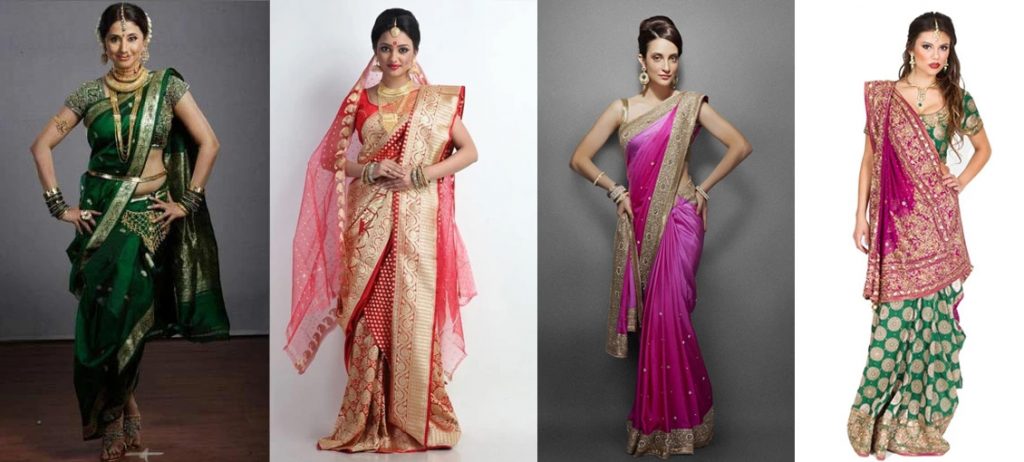
The early statues of Goddesses show that the sari was draped in a sensual manner, like a ‘fishtail’, which was tied at the waist, covered up the legs and came in front of the legs like a decorative drape. During that era, the upper part of the body was either partially covered or was left bare. Down south in the state of Kerala, one can still see people wearing the traditional sari, which is a two piece garment, consisting of a lungi and a shawl. With the coming of the Muslims, the ghagra or the petticoat was discovered and clothes were stitched.
Before that, Hindus believed piercing clothes with needles was impure.
The blouse came into existence with the Muslims and also the British. Since then, sari has come of age and now many new styles are being experimented with. But the main aspects of the sari like the blouse and the petticoat have been carried over in the modern times. Thus, sari is the perfect garment to enhance the beautiful curves of the Indian woman and has done so since times immemorial.
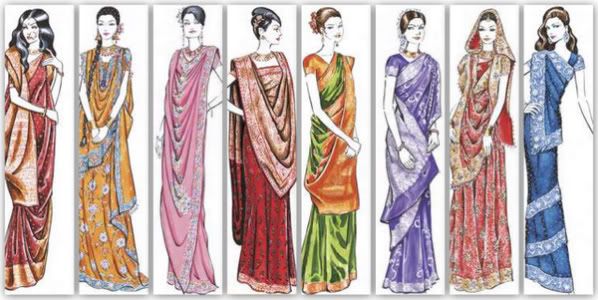
Folk Tale:
“The Sari, it is said, was born on the loom of a fanciful weaver. He dreamt of Woman. The drape of her tumbling hair. The colors of her many moods. The shimmer of her tears. The softness of her touch. All these he wove together. He couldn’t stop. He wove for many yards. And when he was done, the story goes, he sat back and smiled and smiled and smiled.”
The Indian Sari, believe it or not, is more than 5000 years old! It was first mentioned in Rig Veda, the oldest surviving literature of the world, written somewhere around 3000 BC. The Sari, originally intended both for men and women, is probably the longest incessantly worn dress in the history of mankind.
Sari (originally Chira in Sanskrit, meaning Cloth), is a rectangular piece of cloth, usually 5-9 yards in length. The approximate size of a sari, to make it more understandable is 47 inches by 216 inches. For an untailored length of cloth, the fabric of the sari is very well thought-out, and the design vocabulary very sophisticated.
Every Sari has a design theme, and often has a story to tell. The main field of the sari is framed on its three sides by decorative borders. Two of these borders run along the longitudinal sides of the sari, and the third comprises the end piece of the sari, and is known as its Pallav.
The Pallav is a broader, and more intensified version of the two longitudinal borders. This end piece is the part of the sari that is draped over the shoulder and left to hang over the back or front. For example, if the two longitudinal borders have vines with leaves embroidered on them, the end piece or the pallav will have a lush tree with lots of leaves, and maybe even some flowers on it.
India has a diverse and rich textile tradition. The origin of Indian textiles can be traced to the Indus valley civilization. The first literary information about textiles in India can be found in the Rig Veda, which refers to weaving.
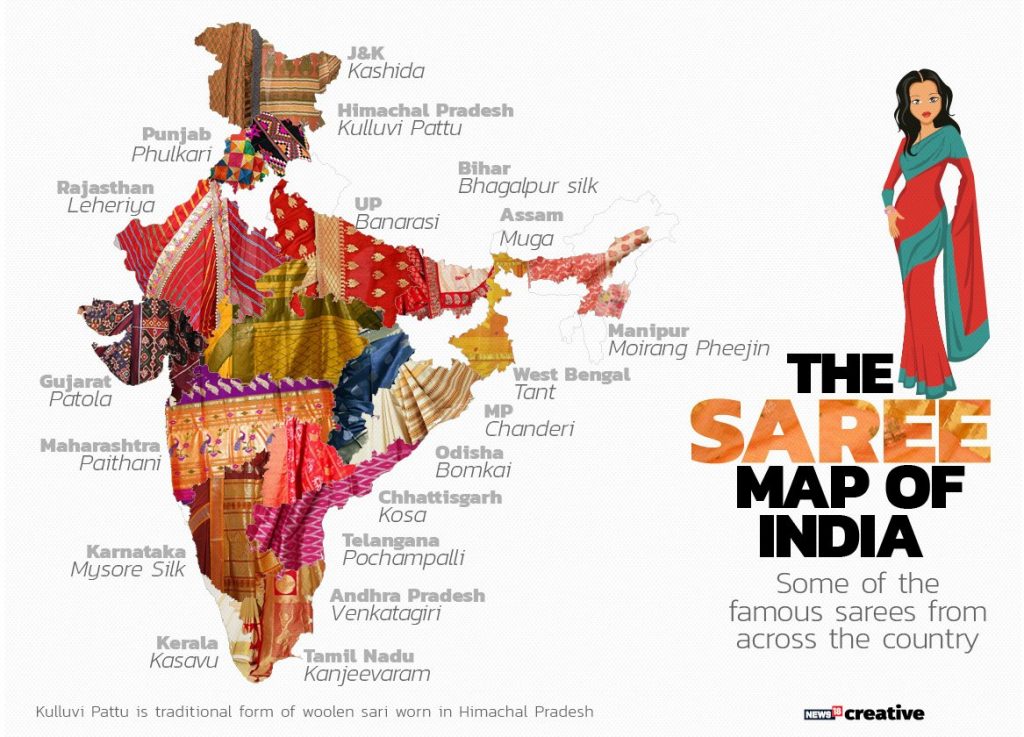
Different Regions, Different Saris:
The four general regions of India are each famous for different kinds of saris:
NORTH:
Bandhni (Rajasthan, Gujarat):
Also known as Tie-Dye or Lehriya, Bandhni saris use an ancient technique of tying the cloth in patterns before dipping it in a dye bath. Rajasthan and Gujarat are famous for these brilliant tie-dyes. Bandhni saris are associated with festivals, seasons, and rituals for which there are particular patterns and colors. You’ll also find them decorated with mirrors and bead work.
Chikan (Lucknow)
Chikan embroidery is a specialty of the Uttar Pradesh city of Lucknow. Its unique style was developed during the Mughal period (from the 16th to the 18th century). It is also called Lakhnavi Chikankari.
Kota Doria (Rajasthan):
Named after Kota, a small district in Rajasthan, this type of sari uses a fine woven fabric containing a checked pattern in the weave itself. These saris are very delicate, lightweight, and porous, which helps with surface ornamentation techniques like tie-dye, hand-block printing, embroidery, and appliqué work.
Banarasi (Benaras):
The Banarasi sari is a must for brides. This classic style came into existence during the Moghul era. The signature design of Banarasi saris is a narrow fringe like pattern – called Jhalar – found along the inner and outer border of the fabric.
Taant (Bengal):
The word Taant literally means “Made on the Loom”. Also known as Bengal Cotton saris, these are a traditional sari type worn by Bengali Women. Taant saris are a must-have for all cotton lovers.
EAST:
Baluchari (West Bengal):
The Baluchari type of sari is about 200 years old. Made of silk and woven on looms, the borders of these saris depict stories from Indian epics like Mahabharata and Ramayana. Baluchari saris use only silk threads – no zari.
Kantha (West Bengal)
Known for its delicate embroidery, Kantha saris are identifiable by a decorative motif with a running stitch. This art is practiced by rural women in West Bengal as a hobby, and each Kantha sari is a result of hard work and labor.
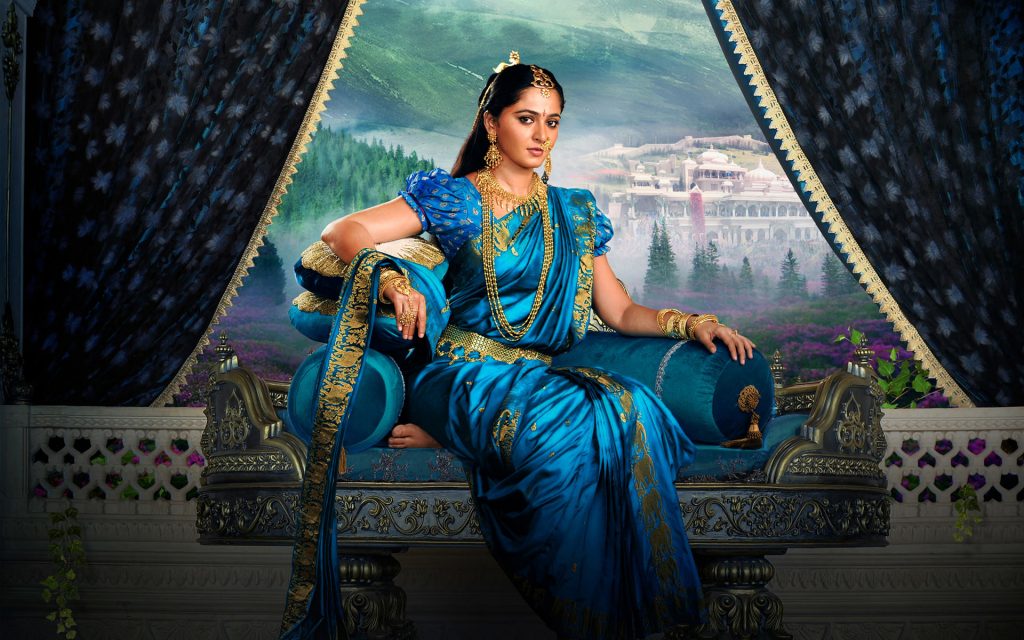
SOUTH:
Kanchipuram (Tamilnadu):
Kanchipuram saris are characterized by the gold-dipped silver thread that is woven into premium quality silk. Kanchipuram is actually a town in Tamilnadu. The town’s fabulous weaving history goes back centuries. Kanchipuram remains untouched by fashion fads, so it still maintains traditional weaving styles and techniques. The silk base of these saris is thicker than any other silk sari, which makes it the most expensive kind of silk sari in India. It is believed that “The heavier is the silk, the better is the quality”. The most common motifs found in Kanchipuram saris are Peacock and Parrot.
Madisar (Tamilnadu):
Madisar is a type of sari which is worn by the Brahmin community (priestesses and scholars) in Tamilnadu. It is a very important part of the Iyer and Iyengar cultures. Brahmins wear Madisar saris for any important occasion – starting with marriage, followed by Seemandham (a sort of baby shower), important poojas (prayer rituals), and death ceremonies. It is 9 yards in length instead of the common 6 yards.
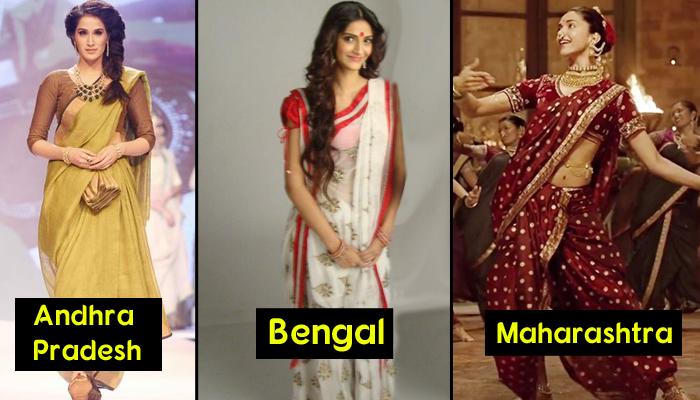
WEST:
Bandhej (Gujarat):
Bandhej saris use the Gujarati style of tie-dye. The multi-coloring method involves working in the lightest shade first, after which the fabric is tied and a darker color is introduced. Any number of color schemes are appropriate. The quality of Bandhej saris can be determined by the size of the dots: The smaller and closer to the size of a pinhead the dots are, the finer is the quality of the Bandhej.
Patola (Gujarat):
“Oh dear, get me those expensive Patola saris with painted peacocks from Patan”, goes a popular Gujarati song. Leading ladies like Sonia Gandhi, Priyanka Gandhi, and Nita Ambani would relate to the lyrics better than many others.
Patola saris are the most time consuming and elaborate of all, as they have intricate five-color designs which are resist-dyed into both warp and weft threads before weaving. Patan, Gujarat produces only 25 to 30 such saris per year. They can cost between Rs. 1 lakh to Rs. 10 lakh (approximately USD $2,000 – $20,000)!
Chanderi (Madhya Pradesh):
The Chanderi sari from Madhya Pradesh is light and meant for Indian summers. It is made in silk or fine cotton.
Bhartiya Culture
Atithi Devo Bhava meaning in Hinduism and India
Published
4 years agoon
November 11, 2021By
Vedic Tribe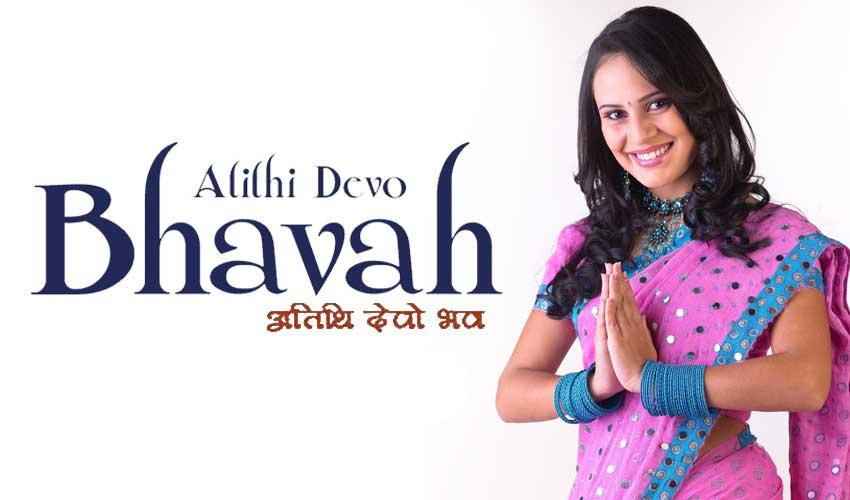
Atithi Devo Bhava, an ancient line taken from the Hindu scriptures and was originally coined to depict a visiting person whose date of arrival and departure is not fixed.
‘Atithi’ originally meaning “without a fixed calendrical time”,’Devo’ meaning “God” and “Bhav” meaning Be or Is, hence signifies The Guest Is God.
Atithi Devo Bhava, it is not just a catchy line to promote tourism but is a beautiful example of a text asking us to respect our guests as God.The host-guest relationship in India is truly one of the most revered relationships. The unique practice of giving utmost importance and preferential treatment to the guests clearly explains the fact that why our country’s history has several notable examples of ‘Atithi Satkar’ meaning to welcome the guest with warmth and respect.
An integral part of the Indian culture, it says that every guest should be treated like God. No distinction should be made based on the guests’s caste, colour or creed and he/she should be showered with all love, care and affection. This unique ‘code of conduct’ laid down in the ancient Hindi scriptures named ‘Taittiriya Upanishad’ upholds our culture’s values and heritage, and ensures no guest of ours feels shortchanged. Despite high degree of cultural and geographical diversity in the country, the sentiments towards the guests stays the same throughout.
Atithi Devo Bhava, has lost its true essence and spirit over the sands of time. Today trade globalization that has helped modernize India, but in the process has also begun to erode its culture. Today where everything travels the fast lane, how much time do we devote towards our rich, age old culture? Today the simplest question that arises is, how many of us are truly aware of the term’Atithi Devo Bhava’ and its origin ? Do we truly lead our lives in this spirit? Atithi Devo Bhava, is an important part of the Indian culture which may soon be lost with time and a country with a lost culture is simply without an identity.
Are we really prepared to leave our successors with a destroyed culture, even after knowing it could be preserved.
Follow us on Facebook
Follow us on Twitter
Latest


Seven Vows and Steps (pheras) of Hindu Wedding explained
Views: 7,633 Indian marriages are well renowned around the world for all the rituals and events forming part of the...


Sari or Saree is symbol of Indian feminism and culture
Views: 6,463 One of the most sensual attires of a woman in India is undoubtedly the sari. It is a...


Atithi Devo Bhava meaning in Hinduism and India
Views: 5,805 Atithi Devo Bhava, an ancient line taken from the Hindu scriptures and was originally coined to depict a visiting person whose...


Sanskrit Is More Than Just A Method To Communicate
Views: 4,702 -By Ojaswita Krishnaa Chaturvedi anskrit is the language of ancient India, the earliest compilation of sound, syllables and...


Significance of Baisakhi / Vaisakhi
Views: 5,852 Baiskhi is also spelled ‘Vaisakhi’, and is a vibrant Festival considered to be an extremely important festival in...


Navaratri: The Nine Divine Nights of Maa Durga!
Views: 6,879 – Shri Gyan Rajhans Navratri or the nine holy days are auspicious days of the lunar calendar according...


History of Vastu Shastra
Views: 9,498 Vastu Shastra (or short just Vastu) is the Indian science of space and architecture and how we may...


Significance of Bilva Leaf – Why is it dear to Lord shiva?
Views: 9,068 – Arun Gopinath Hindus believe that the knowledge of medicinal plants is older than history itself, that it...


Concept of Time and Creation (‘Brahma Srishti’) in Padma Purana
Views: 9,480 Pulastya Maha Muni affirmed to Bhishma that Brahma was Narayana Himself and that in reality he was Eternal....


Karma Yoga – Yog Through Selfless Actions
Views: 8,745 Karma Yoga is Meditation in Action: “Karma” means action and “yoga” means loving unity of our mind with...


